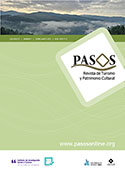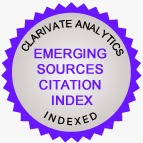Análisis de las percepciones sobre el empleo de personas con discapacidades especiales en la industria hotelera india
DOI:
https://doi.org/10.25145/j.pasos.2025.23.011Palabras clave:
Discapacidad, Inclusividad, Prácticas de contratación, Empleados con discapacidades especiales, Industria hotelera, Elaboración de políticas, Diversificación, IndiaResumen
La diversidad y la inclusión (D&I) se han convertido en una prioridad empresarial para la mayoría de las organizaciones de todos los sectores, ya que se ha demostrado que fomentan la creatividad, la innovación y la moral de los empleados, además de productividad y resultados, al tiempo que contribuyen a avanzar hacia una economía más igualitaria. El empoderamiento de las personas con discapacidad a través de las oportunidades de empleo es una prioridad en muchas organizaciones, incluidas las de la hostelería, donde los huéspedes suelen percibir lso espacios inclusivos como más acogedores, cómodoss y cálidos. El presente estudio pretende examinar las prácticas de empleo de personas con discapacidades especiales en la industria hotelera india. Se adoptó un diseño de investigación exploratorio. Se utilizó un diseño en dos fases para explorar el tema y encontrar nuevas dimensiones de investigación. El estudio también reveló las oportunidades y los obstáculos en el proceso y cómo se pueden resolver para aumentar su empleo para una vida digna, y una sociedad india inclusiva. Se trató de conectar la demanda de mano de obra competente en el sector hotelero indio con las necesidades de empleo de las personas con discapacidades especiales.
Descargas
Datos de publicación
Perfil evaluadores/as N/D
Declaraciones de autoría
- Sociedad académica
- PASOS. Revista de Turismo y Patrimonio Cultural
- Editorial
- Instituto Universitario de Investigación Social y Turismo. Universidad de La Laguna (España) - Instituto Universitario da Maia ISMAI (Portugal)
Citas
Ahmad, F. K. (2015). Use of Assistive Technology in Inclusive Education : Making Room for Diverse Learning Needs. Transcience, 6(2).
Aichner, T. (2021). The economic argument for hiring people with disabilities. In Humanities and Social Sciences Communications (Vol. 8, Issue 1). Springer Nature. https://doi.org/10.1057/s41599-021-00707-y
Alsayyed, N., Jalil Sweis, R., El-Mashaleh, M., Sweis, R. J., Ghalion, R., Amayreh, I., Niveen, A.-S., & Al Balkhi, W. (2019). The Effects of Training and Motivating Employees on Improving Performance of Construction Companies The Case of Jordan, International Journal of Information, Business and Management, 11(2). https://www.researchgate.net/publication/333089038
Angela, B. M. (2015). Employment of Persons with Disabilities. Procedia - Social and Behavioral Sciences, 191, 979–983. https://doi.org/10.1016/j.sbspro.2015.04.540
Azlan, A. L., & Rashid, R. M. (2013). Employment Core Abilities Skills among Trainees with Physical Disabilities in Malaysia. Procedia - Social and Behavioral Sciences, 93(2005), 1760–1765. https://doi.org/10.1016/j.sbspro.2013.10.112
Bengisu, M., & Balta, S. (2011). Employment of the workforce with disabilities in the hospitality industry. Journal of Sustainable Tourism, 19(1), 35–57. https://doi.org/10.1080/09669582.2010.499172
Boman, T., Kjellberg, A., Danermark, B., &Boman, E. (2015). Employment opportunities for persons with different types of disability. Alter, 9(2), 116–129. https://doi.org/10.1016/j.alter.2014.11.003
Chan, M., & Zoellick, R. B. (2011). Summary world report on disability. World Health Organization & The World Bank.
Donnelly, K., & Joseph, J. (2012). Disability Employment in the Hospitality Industry: Human Resources Considerations. Cornell HR Review, 1–14. http://search.ebscohost.com/login.aspx?direct=true&db=bth&AN=92616099&site=ehost-live&scope=site
General, R., & Commissioner, C. (2011). Measurement of Disability through Census. 1–43.
Groschl, S. (2011). Employment barriers for persons with disabilities in the hotel industry: A reality check. International CHRIE Conference, 7. http://scholarworks.umass.edu/refereed/ICHRIE_2011/Thursday/5/
Grześkowiak, A., Załuska, U., Kozyra, C., &Kwiatkowska-Ciotucha, D. (2021). Perception and acceptance of people with disabilities by employers and co-workers. International Journal of Environmental Research and Public Health, 18(10). https://doi.org/10.3390/ijerph18105278
Gupta, M., &Ravindranath, S. (2018). Managing Physically Challenged Workers at Microsign. South Asian Journal of Business and Management Cases, 7(1), 34–40. https://doi.org/10.1177/2277977918759868
ILO, & OECD. (2018). Labour market inclusion of people with disabilities. 1st Meeting of the G20 Employment Working Group, February, 1–20.
International Labour Office. (2008). Skills development through community based rehabilitiation (CBR) : a good practice guide. International Labour Office.
ITC Hotels India. (2016). A Guide to Universal Design in Built Environments. https://www.itcportal.com/businesses/hotel-manual.pdf
Kalargyrou, V., &Volis, A. A. (2014). Disability Inclusion Initiatives in the Hospitality Industry: An Exploratory Study of Industry Leaders. Journal of Human Resources in Hospitality and Tourism, 13(4), 430–454. https://doi.org/10.1080/15332845.2014.903152
Kalargyrou, V., Kalargiros, E., &Kutz, D. (2020). Social Entrepreneurship and Disability Inclusion in the Hospitality Industry. International Journal of Hospitality and Tourism Administration, 21(3), 308–334. https://doi.org/10.1080/15256480.2018.1478356
Kalargyrou, V., Barber, N.A. and Kuo, P.-J. (2018), "The impact of disability on guests’ perceptions of service quality delivery in the hospitality industry", International Journal of Contemporary Hospitality Management, Vol. 30 No. 12, pp. 3632-3655. https://doi.org/10.1108/IJCHM-06-2017-0362
Kaur, A. (2017). Differently abled Persons and Human Rights: Issues and Responses. International Journal of Law and Legal Jurisprudence Studies, 2(1), 2348–8212.
Kaye, H. S., Jans, L. H., & Jones, E. C. (2011). Why don’t employers hire and retain workers with disabilities? Journal of Occupational Rehabilitation, 21(4), 526–536. https://doi.org/10.1007/s10926-011-9302-8
Kennedy, J., Wood, E. G., & Frieden, L. (2017). Disparities in insurance coverage, health services use, and access following implementation of the affordable care act: A comparison of disabled and nondisabled working-age adults. Inquiry (United States), 54. https://doi.org/10.1177/0046958017734031
Keynes, J. M. (1937). The general theory of employment. The quarterly journal of economics, 51(2), 209-223.
Kitchener, K. S., & Kitchener, R. F. (2014). Social Science Research Ethics: Historical and Philosophical Issues. In The Handbook of Social Research Ethics (pp. 5–22). SAGE Publications, Inc. https://doi.org/10.4135/9781483348971.n1
Kothari, J. (2012). The future of disability law in India: A critical analysis of the persons with disabilities (Equal Opportunities, Protection of Rights and Full Participation) Act 1995. Oxford University Press.
Kuckartz, U., Manzano, J., & Li Ping, W. (n.d.). Qualitative Text Analysis with MAXQDA Data analysis in qualit at ive research: A brief guide t o using NVivo. ErApplicat Ions in Qualit at Ive Research: A Review Asia Pacific Journal of Academic Research in Social Sciences. www.winmax.de
Luu, T. T. (2018). Engaging employees with disabilities in Vietnamese business context: The roles of disability inclusive HR practices and mediation and moderation mechanisms. Employee Relations, 40(5), 822–847. https://doi.org/10.1108/ER-06-2017-0134
Luu, T. T. (2019). The well-being among hospitability employees with disabilities: The role of disability inclusive benevolent leadership. International Journal of Hospitality Management, 80, 25–35. https://doi.org/10.1016/j.ijhm.2019.01.004
McDonnall, M. C., & Lund, E. M. (2020). Employers’ Intent to Hire People Who Are Blind or Visually Impaired: A Test of the Theory of Planned Behavior. Rehabilitation Counseling Bulletin, 63(4), 206–215. https://doi.org/10.1177/0034355219893061
McDonnall, M. C., &Crudden, A. (2018). Predictors of employer attitudes toward blind employees, revisited. Journal of Vocational Rehabilitation, 48(2), 221–231. https://doi.org/10.3233/JVR-180933
McIntosh, A., & Harris, C. (2018). Representations of hospitality at The Special Needs Hotel. International Journal of Hospitality Management, 75, 153–159. https://doi.org/10.1016/j.ijhm.2018.05.021
Meacham, H., Cavanagh, J., Bartram, T., & Laing, J. (2019). Ethical Management in the Hotel Sector: Creating an Authentic Work Experience for Workers with Intellectual Disabilities. Journal of Business Ethics, 155(3), 823–835. https://doi.org/10.1007/s10551-017-3499-1
Meacham, H., Cavanagh, J., Shaw, A., & Bartram, T. (2017). HRM practices that support the employment and social inclusion of workers with an intellectual disability. Personnel Review, 46(8), 1475–1492. https://doi.org/10.1108/PR-05-2016-0105
Mehrotra, N. (2011). Disability rights movements in India: Politics and practice. Economic and Political Weekly, 46(6), 65–72.
Mehrotra, S., Gandhi, A., Saha, P., &Sahoo, B. K. (2012). Joblessness and Informalization: Challenges to Inclusive Growth in India. 9, 1–22.
Mehrotra, V. S. (2016). NVEQF: Skill Development under the National Skills Qualifications Framework in India: Imperatives and Challenges. In M. Pilz (Ed.), India: Preparation for the World of Work. (pp. 281–310). Springer VS. https://doi.org/https://doi.org/10.1007/978-3-658-08502-5_14
Menon, N., Parish, S. L., & Rose, R. A. (2014). The “State” of Persons with Disabilities in India. Journal of Human Development and Capabilities, 15(4), 391–412. https://doi.org/10.1080/19452829.2014.938729
Ministry of Statistics and Programme Implementation, National Sample Survey, G. of I. (2016). Disabled persons in India: A statistical profile. 0–107. http://mospi.nic.in/sites/default/files/publication_reports/Disabled_persons_in_India_2016.pdf
Mitra, S. (2013). A data revolution for disability-inclusive development. In The Lancet Global Health (Vol. 1, Issue 4). https://doi.org/10.1016/S2214-109X(13)70016-0
Mitra, S., &Sambamoorthi, U. (n.d.). Disability Estimates in India: What the Census and NSS Tell Us (Vol. 41, Issue 38).
Mori, Y., & Sakamoto, N. (2018). Economic consequences of employment quota system for disabled people: Evidence from a regression discontinuity design in Japan. Journal of the Japanese and International Economies, 48, 1–14. https://doi.org/10.1016/j.jjie.2017.02.001
MoSPI. (2020). Sustainable Development Goals Progress Report 2020 National Indicator Framework. http://mospi.nic.in/sites/default/files/publication_reports/SDGProgressReport2020.pdf
Paez, P. (2011). Training methods and topics for hospitality employees with disabilities: Managers’ attitudes and perceived knowledge. Dissertation Abstracts International Section A: Humanities and Social Sciences, 72(3-A), 1005. http://search.ebscohost.com/login.aspx?direct=true&db=psyh&AN=2011-99170-394&login.asp&site=ehost-live&scope=site
Paez, P., & Arendt, S. W. (2014). Managers’ Attitudes Towards People with Disabilities in the Hospitality Industry. International Journal of Hospitality and Tourism Administration, 15(2), 172–190. https://doi.org/10.1080/15256480.2014.901065
Paez, P., Arendt, S., &Strohbehn, C. (2011). Training: An Opportunity for People with Disabilities in School Foodservice Operations. Journal of Child Nutrition & Management,35(1),1–11. https://search.proquest.com/docview/881470208
Pellicena, M. À., Ivern, I., Giné, C., &Múries, O. (2020). Facilitating factors for the job placement of workers with intellectual disabilities: supervisors and coworker mentors perspectives. Advances in Mental Health and Intellectual Disabilities, 14(6), 213–227. https://doi.org/10.1108/AMHID-11-2019-0036
Raj, H., Kumar, H., & Nataraj, M. (2022). Welfare policy and labour market outcomes among persons with disabilities (PwDs) in India: Evidence from the NSS 76th Round.
Rao, B., &Polepeddi, J. (2019). Neurodiverse workforce: inclusive employment as an HR strategy. Strategic HR Review, 18(5), 204–209. https://doi.org/10.1108/shr-02-2019-0007
Robins, R., Martin, D., Durai Raj, K., & Raju, M. S. (2006). Awareness about the persons with disability act among leprosy patients and other disabled persons. Indian Journal of Leprosy, 78(3), 217–229.
S.Rajamohan and S.D.Elango. (2020). Entrepreneurial Education for Differently Abled People In India. International Journal of Psychosocial Rehabilitation ·, 24(05), 8922–8930. https://dwcla.repo.nii.ac.jp
Saikia, N., Bora, J. K., Jasilionis, D., &Shkolnikov, V. M. (2016). Disability divides in India: Evidence from the 2011 census. PLoS ONE, 11(8). https://doi.org/10.1371/journal.pone.0159809
Saleh, M. C., &Bruyère, S. M. (2018). Leveraging employer practices in global regulatory frameworks to improve employment outcomes for people with disabilities. Social Inclusion, 6(1), 18–28. https://doi.org/10.17645/si.v6i1.1201
Saranya Devi, E., & Rajamohan, S. (2021). Educational Policy and Employment Opportunity of People with Disabilities in India - A Study. Shanlax International Journal of Management, 9(1), 60–65. https://doi.org/10.34293/management.v9i1.3898
Sarkar, A. (2018). RPWD Act, 2016: Fostering a Disability-friendly Workplace in Indian Organizations. Indian Journal of Industrial Relations, 53(4), 591–603. http://ezproxy.library.ubc.ca/login?url=http://search.ebscohost.com/login.aspx?direct=true&db=bth&AN=130127821&site=ehost-live&scope=site
Shah, S. (2010). Role of Family in Empowering the Young Disabled People. International Journal of Disability Studies, 4(1), 100–125.
The Rights of Persons with Disabilities Act , 2016 An Act to give effect to the United Nations Convention on the Rights of Persons with Disabilities and for matt, 1 (2016).
Vasanthi, N. (2020). The Right to Work for Persons with Disability in India: A Critical Disability Theory Perspective. In N. Mehrotra (Ed.), Disability Studies in India (pp. 9–14). Springer Singapore International Publishing. https://doi.org/https://doi.org/10.1007/978-981-15-2616-9_14
Vasanthi, S., &Basariya, S. R. (2018). Employee cross training and its impact on employee performance. International Journal of Civil Engineering and Technology, 9(6), 800–806. https://doi.org/10.13140/RG.2.2.33517.23525
Vashishth, A., & Jhamb, D. (2021). Why should employers hire people with disabilities? - a review of benefits for the hospitality industry. Journal of Tourism and Development, 2021(35), 9–22. https://doi.org/10.34624/rtd.v0i35.24613
Vashishth, A., Verma, V., Saini, A., &Jhamb, D. (2019). Workforce diversity - challenges in inclusion of people with disabilities in the hospitality industry. Indian Journal of Public Health Research and Development, 10(8), 195–200. https://doi.org/10.5958/0976-5506.2019.01877.1
Verick, S. (2021). Do Financial Incentives Promote the Employment of the Disabled? SSRN Electronic Journal, 1256. https://doi.org/10.2139/ssrn.579705
Vornholt, K., Uitdewilligen, S., &Nijhuis, F. J. N. (2013). Factors affecting the acceptance of people with disabilities at work: A literature review. In Journal of Occupational Rehabilitation (Vol. 23, Issue 4, pp. 463–475). https://doi.org/10.1007/s10926-013-9426-0
Vornholt, K., Villotti, P., Muschalla, B., Bauer, J., Colella, A., Zijlstra, F., Van Ruitenbeek, G., Uitdewilligen, S., &Corbière, M. (2018). Disability and employment–overview and highlights. European Journal of Work and Organizational Psychology, 27(1), 40–55. https://doi.org/10.1080/1359432X.2017.1387536
Wescott, H. N., MacLachlan, M., & Mannan, H. (2020). Disability Inclusion and Global Development: A Preliminary Analysis of the United Nations Partnership on the Rights of Persons with Disabilities programme within the context of the Convention on the Rights of Persons with Disabilities and the Sustainable Development Goals. Disability, CBR & Inclusive Development, 31(4), 90-115.
Williams, B., Onsman, A., & Brown, T. (2010). Exploratory factor analysis: A five-step guide for novices. Australasian journal of paramedicine, 8, 1-13.
Yaruss, J. S., & Quesal, R. W. (2004). Stuttering and the international classification of functioning, disability, and health (ICF): An update. Journal of communication disorders, 37(1), 35-52.
Descargas
Publicado
Cómo citar
Número
Sección
Licencia
Derechos de autor 2024 Amrik Singh

Esta obra está bajo una licencia internacional Creative Commons Atribución-NoComercial-SinDerivadas 4.0.
Confirmo que el trabajo es original (de mi/nuestra autoría), y que no se someterá a otras revistas o publicaciones hasta la resolución definitiva del proceso de revisión en PASOS, RTPC.
Autorizo la publicación de mi trabajo por PASOS, RTPC de acceso abierto y gratuito en cualquiera de los formatos que estime oportunos, por un plazo indeterminado y a título de colaboración no remunerada.
Asimismo, el/los autor/es entiende/n que el trabajo publicado podrá vincularse o depositarse en cualquier servidor o ser incluido en otras publicaciones (republicación), siempre y cuando el nuevo lugar y/o la nueva edición referencie la publicación original y reconozca la autoría y la propiedad del copyright de las publicaciones de PASOS RTPC.
Los/as autores/as entienden que se realizará una comprobación de plagio-autoplagio, pudiendo retirarse el artículo en cualquier momento del flujo editorial










